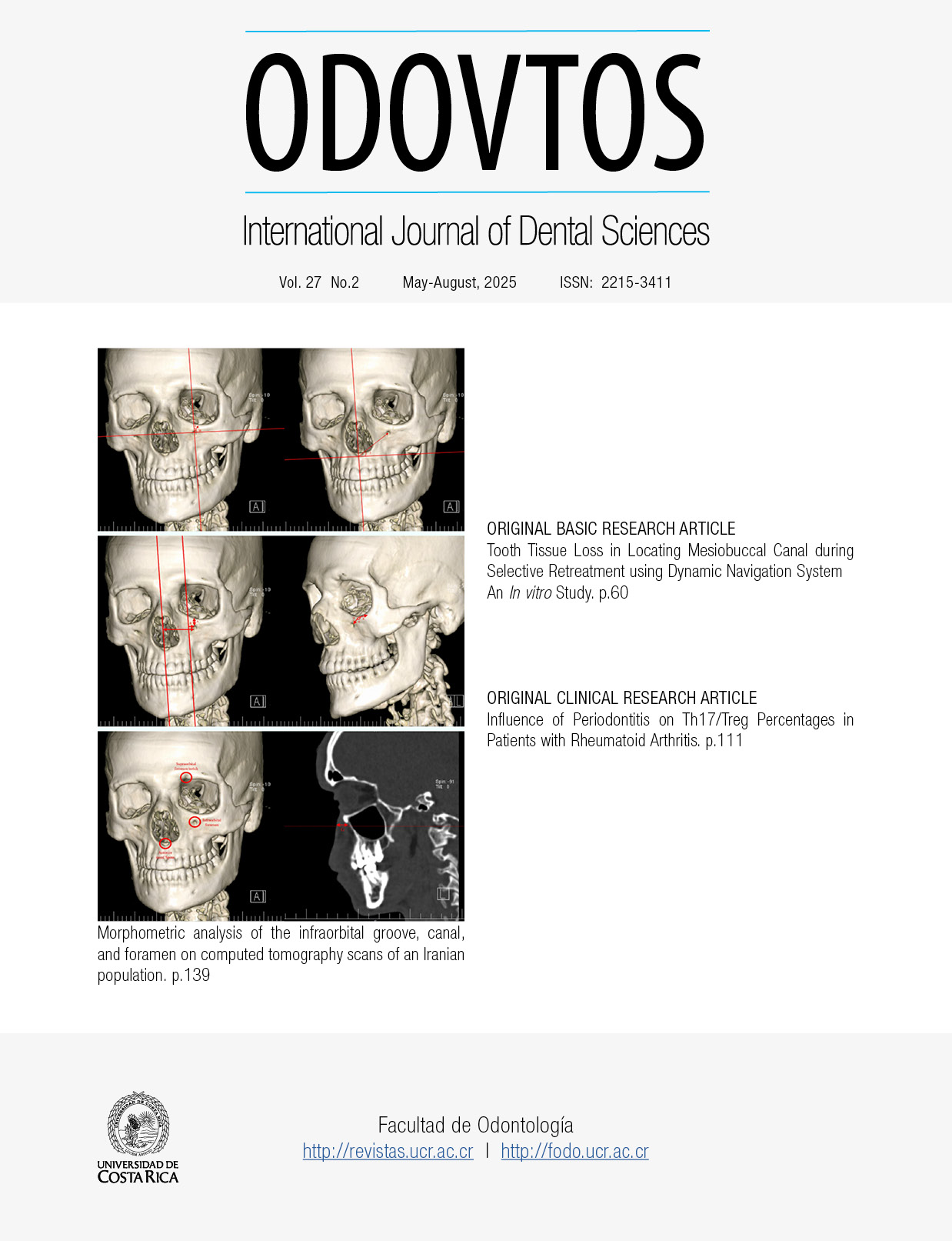Abstract
There is no consensus in clinical orthodontics on which aligning arch wire should be used at the initial stage of treatment. This randomized clinical trial evaluated the efficiency of multistranded Nitinol (Supercable) aligning arch-wire versus a standard arch-wire (Nitinol) in the first stage of orthodontic treatment in adolescents with severe crowding. Forty patients ages 12 to 17 with an Irregularity Index as proposed by Little between 5 to 17 mm were selected. Vinyl polysiloxane impressions (VPS) were taken before treatment (T1) at 6 weeks (T2) and 12 weeks (T3). Roth prescription .022 x .028 Edgewise brackets were bonded using light cure adhesive to the six anterior teeth of each dental arch and bands were placed on all first molars. Subjects were paired by gender and Irregularity Index into two groups of 20 each and assigned either to the control group (Nitinol) or the experimental archwire (Supercable). The predictor variables in this study were the type of archwire, type of dental arch and the time intervals. The outcome variable was the Irregularity Index score. The Irregularity Index was measured using 3D digital study models (e-models) and GeoDigm software from the VPS impressions taken at T1, T2 and T3. The data was analyzed with both a Two and Three-way Analysis of Variance (p≤0.05) to identify differences in the alignment of the maxillary and mandibular teeth and to determine differences between the two archwires. The Two and Three way ANOVA showed that there was a statistically significant difference (p≤0.05) in the alignment capabilities between the maxilla and the mandible. However, there was no evidence of a statistically significant difference (p=0.301) between NiTi and Supercable archwires at any time interval.
References
Montasser M.A., Keiling L., Bourauel C. Archwire diameter effect on tooth alignment with different bracket-archwire combinations. Am J of Orthod. 2016; 149: 76-83.
Pandis N., Polychronopoulou A., Eliades T. Alleviation of mandibular anterior crowding with copper-nickel-titanium vs nickel-titanium wires : A double-blind randomized control trial. Am J of Orthod. 2009; 136: 152.e1-152.e7.
Rucker B.K., Kusy R. Elastic properties of alternative versus single-stranded leveling archwires. Am J of Orthod. 2002; 122: 528-541.
Gurgel J., Kerr S., Powers J.M., LeCrone V. Force-deflection properties of superelastic nickel-titanium archwires. Am J Orthod Dentofac Orthop. 2001;120: 378-382.
Santoro M., Nicolay O.F., Cangialosi T.J. Pseudoelasticity and thermoelasticity of nickel-titanium alloys: A clinically oriented review. Part I: Temperature transitional ranges. Am J Orthod Dentofac Orthop. 2001;119: 587-593.
Eliades T., Eliades G., Athanasion A.E., Bradley T.G. Surface characterization of retrieved NiTi orthodontic archwires. Eur J Orthod. 2000; 22 (3): 317-26.
Gianelly A. Evidence-based treatment strategies: An ambition for the future. Am J Orthod Dentofac Orthop. 2000; 117 May: 543-544.
O’Brien K.D. A Clinical Trial of Aligning AW. Eur J Orthod. 1990;12: 380-383.
Cobb N., Kula K., Phillips C., Proffit W. Efficiency of multi-strand Steel Superelastic NiTi and Ion Implanted NiTi AW for Initial Alignment. Clinical Orthod Res. 1998; 114: 12-19.
Jones M.L., Staniford H., Chan C. Comparison of Superelastic NiTi and Multistranded Stainless Steel wires in Initial Alignment. J Clin Orthod. 1990; 24 (10): 611-613.
Berger J., Byloff F., Waram T. Supercable and the Speed System. Journal of Clinical Orthod. 1998; 32 (4): 246-253.
Little R.M. The Irregularity Index: A quantitative score of mandibular anterior alignment. Am J of Orthod. 1975; 68 (5): 554-563.
Wilkinson J.V. Some Metallurgical aspects of Orthodontic Stainless Steel. Angle Orthod. 1962; 48: 192-206.
Lane D.F., Nikolai R.J. Effects of Stress Relief on the Mechanical Properties of Orthodontic Wire Loops. Angle Orthod. 1980; 50: 139-145.
Burstone C.J., Qin B., Morton J.Y. Chinese NiTi Wire: A new Orthodontic Alloy. Am J Orthod. 1985; 87: 445-452.
Miura F., Mogi M., Ohura Y. The Super-Elastic Property of the Japanese NiTi Alloy Wire for Use in Orthodontics. Am J Orthod Dentofac Orthop. 1986; 90: 1-10.
Kapila S., Sachdeva R. Mechanical properties and clinical applications of orthodontic wires. Am J Orthod Dentofacial Orthop. 1989; 96: 100-109.
Kusy R.P. Friction between different wire-bracket configurations and materials. Sem. Orthod. 1997; 3: 166-177.
Rock W.P, Wilson H.J. Forces exerted by orthodontic aligning arch wires. Br J Orthod. 1988;15: 255-259.
Waters N.E., Houston W.J.B., Stephens C.D. The characterization of arch wires for the initial alignment of irregular teeth. Am J Orthod. 1981; 79: 373-389.
Andreasen G.F. A Clinical Trial of alignment of teeth using a 0.019 thermal Nitinol wire with a transition temperature range between 310C and 450C. Am J Orthod. 1980;78: 528-532.
Richmond S., Shaw W.C., Stephens C.D. The PAR index, reliability and validity. Eur J Orthod. 1992; 14: 125-139.
Evans T.J, Jones M.L,Newcombe R.G. Clinical comparison and performance perspective of three aligning arch wires. Am J Orthod Dentofac Orthop. 1998; July 114: 32-39.
##plugins.facebook.comentarios##

This work is licensed under a Creative Commons Attribution-NonCommercial-ShareAlike 4.0 International License.
Copyright (c) 2024 Ivette Sáenz


